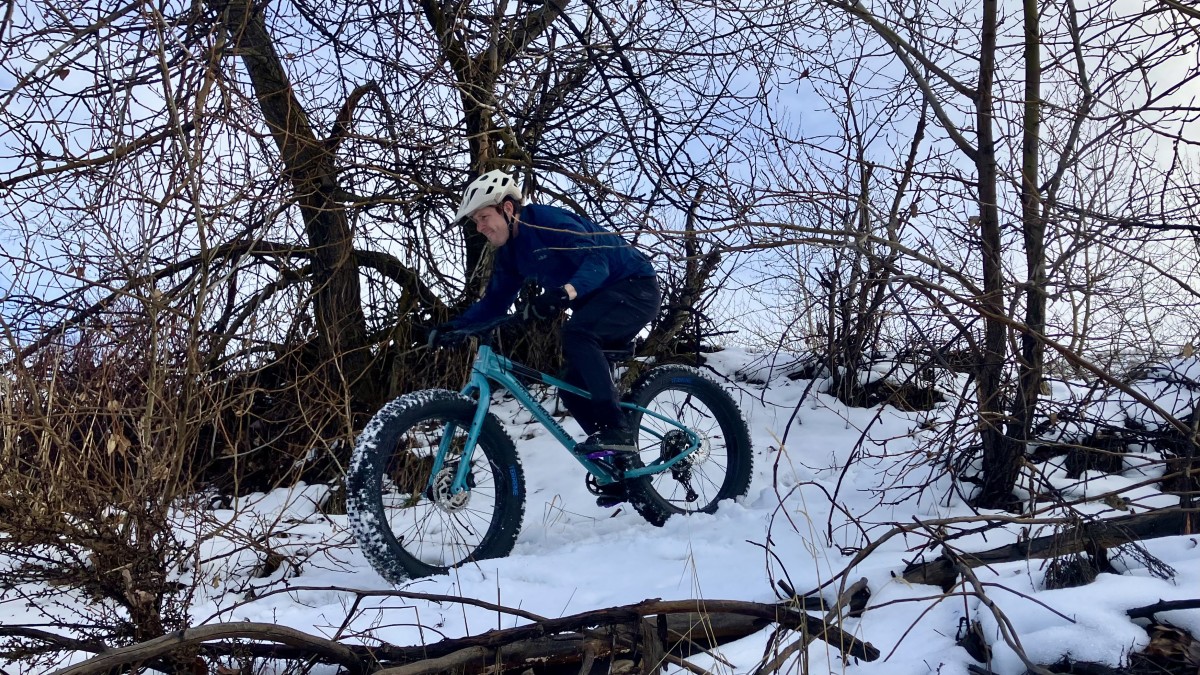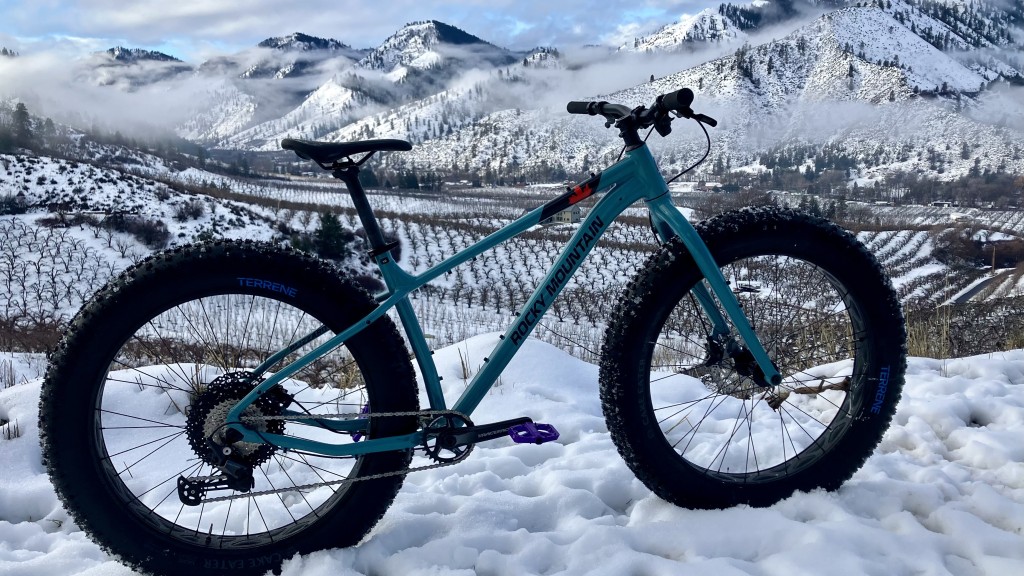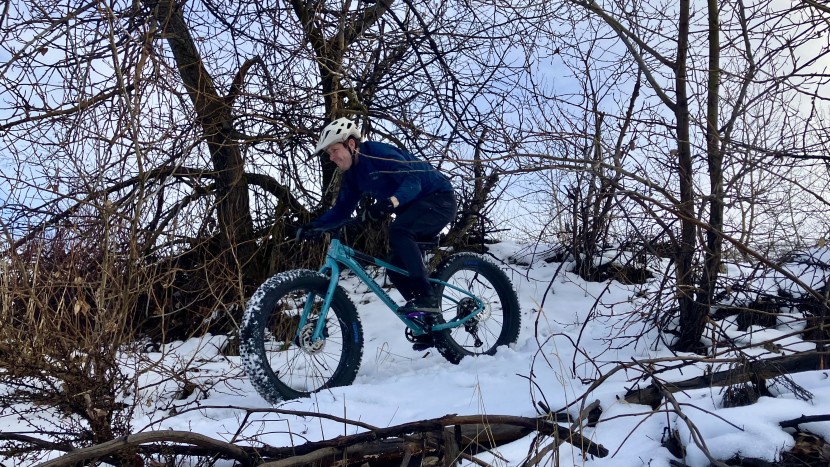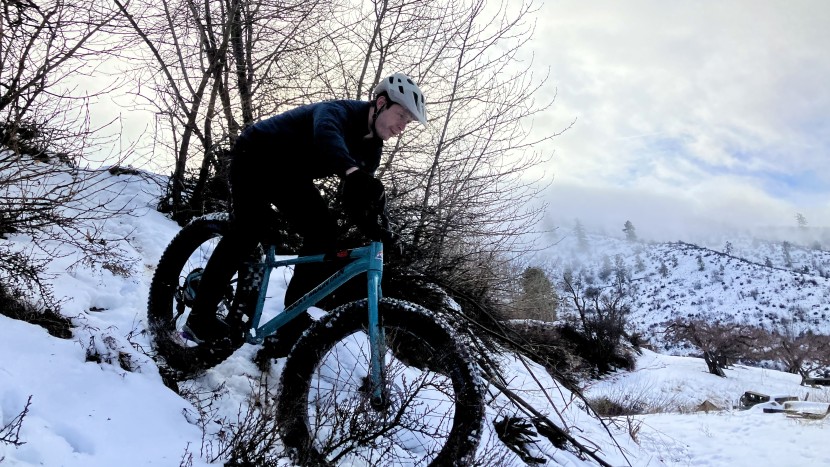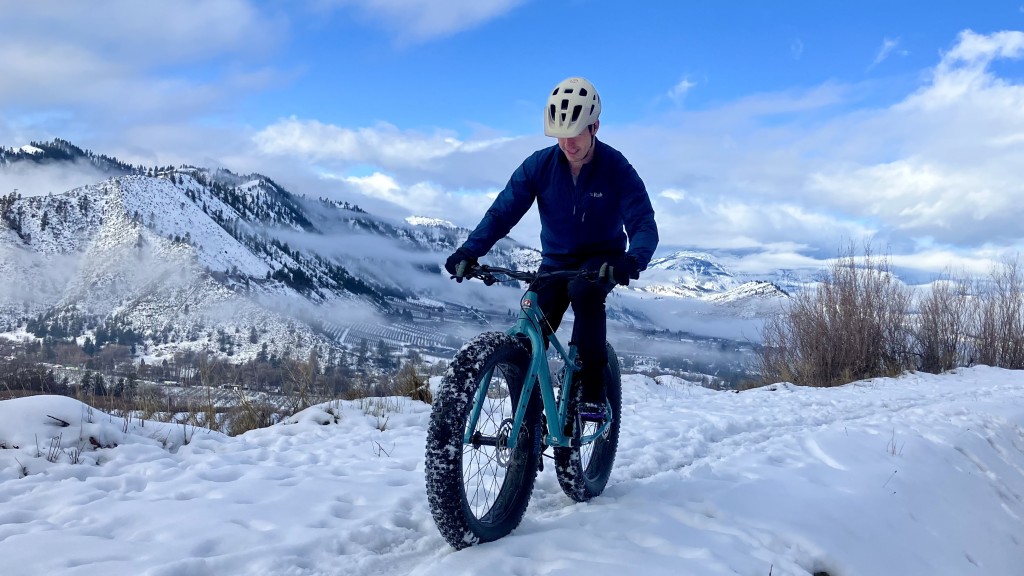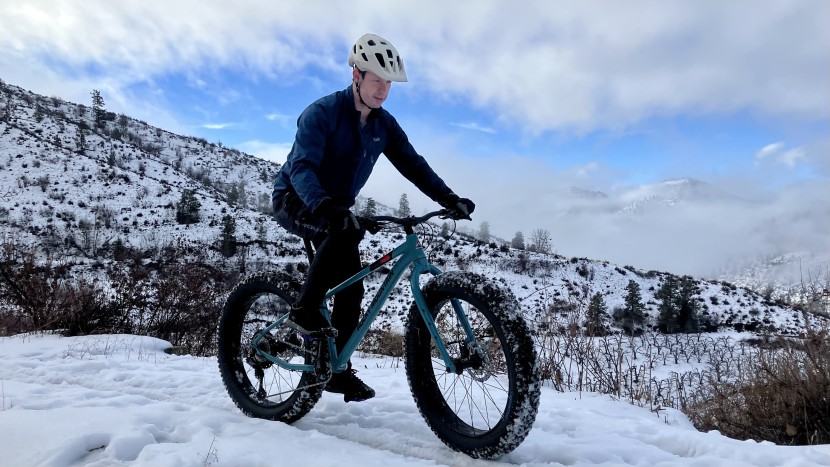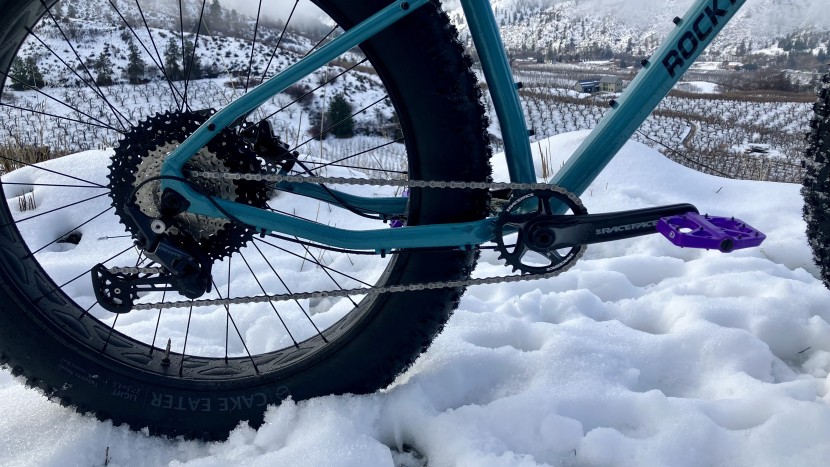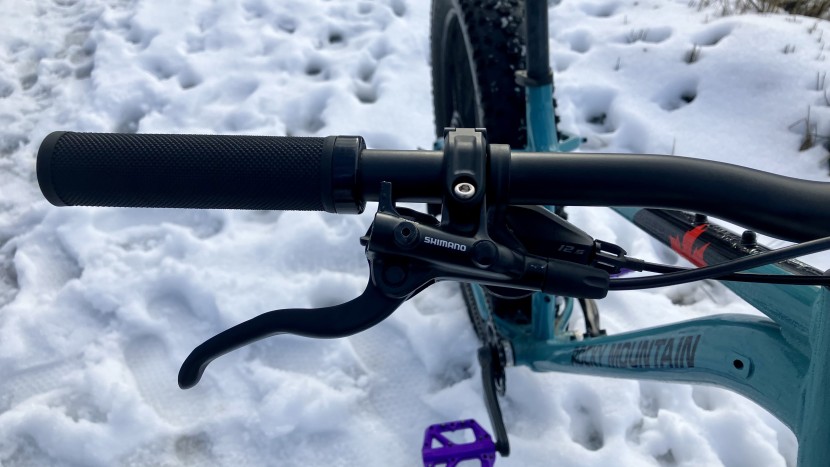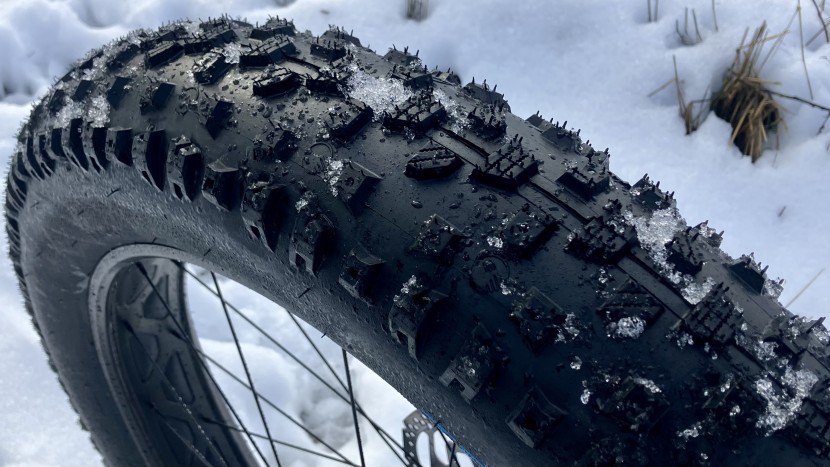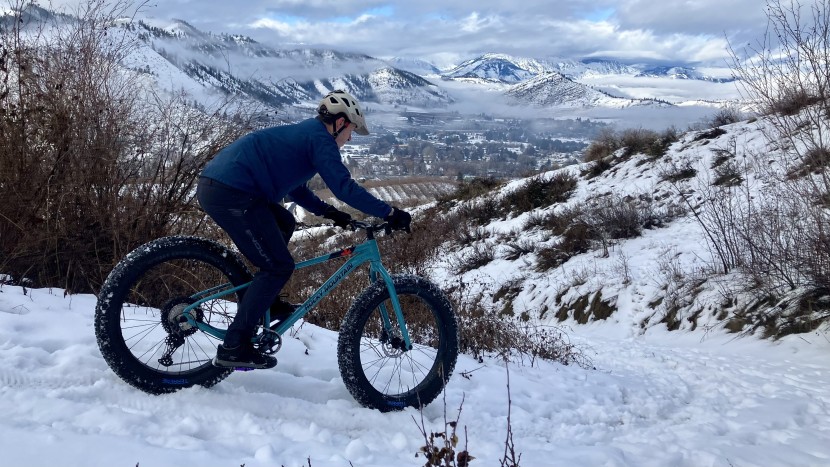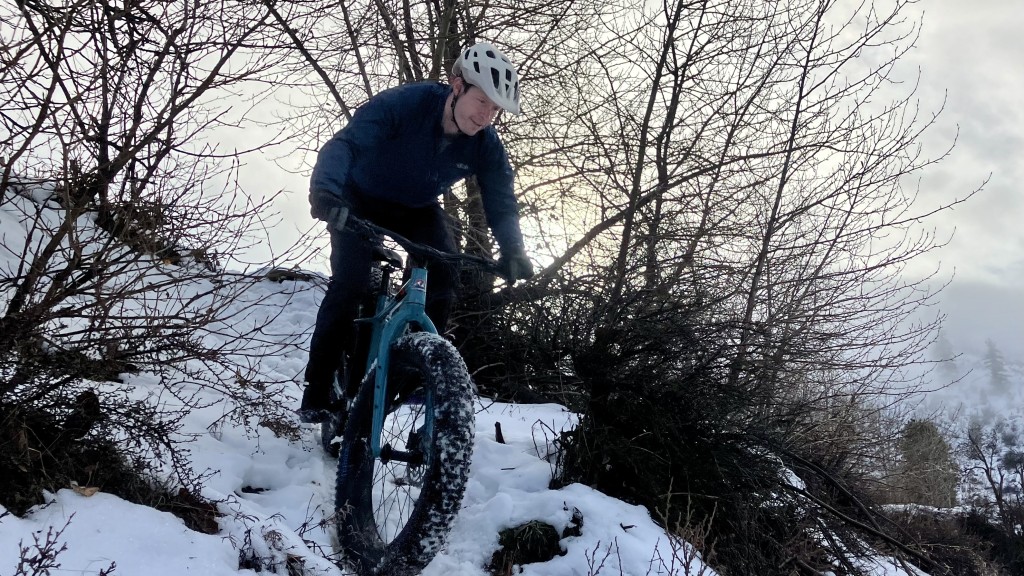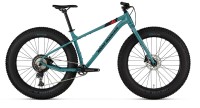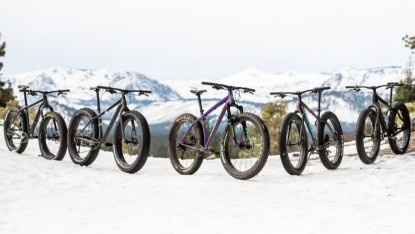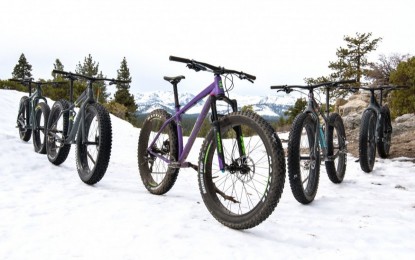Rocky Mountain Blizzard A20 Review

Our Verdict
Our Analysis and Test Results
The Blizzard A20 is a rock-solid fat bike. Downhill performance was a clear, strong suit as long as you have terrain that allows you to open up the throttle. This bike also performed quite well when descending snow-free singletrack. Uphill performance and versatility were fine. The build was impressive for the reasonable price tag, and the Shimano Deore 12-speed continues to stand out as a tremendous budget-friendly drivetrain.
Downhill Performance
The Blizzard is an interesting bike on the descent. It is an absolute weapon when you can get it up to speed and allow its long and slack (by fat bike standards) geometry to work its magic. At slower speeds, it can feel like a bit of a handful in those situations where a slightly shorter bike might be more suitable.
When perched atop the Blizzard, the bike has a very familiar feel. The 66-degree head angle and relatively spacious 475mm reach (size large) feel similar to a modern trail bike. Rolling into steeper sections of the trail felt confident and familiar. The longer 1227mm wheelbase is very stable at speed.
This long(ish) and slack(ish) geometry brings us to our main beef with this plump bicycle. This bike felt exceptionally good at high speed when you can let off the brakes and let it run. It feels incredibly stable and confident when you open it up. This sounds like a positive attribute, and it is. That being said, the average speed of fat bike rides tends to be much slower than a normal mountain bike ride. We have found that conservative geometry and shorter wheelbases can be advantageous most of the time. These shorter bikes feel quicker and more lively, especially when the speeds are slower.
The Blizzard offers decent handling. As previously mentioned, it struggles a bit in tight spaces, but the Terrene Cake Eater 27.5 x 4.5-inch tires respond well to quick and aggressive movements. The braking bite is solid. We landed on about 8 PSI front and rear with these tires to balance the damping properties provided by these enormous tires while avoiding the risk of burping the tires. Once the tire pressure was dialed in, we found the ride to be reasonably compliant. We had the opportunity to ride this bike on some south-facing dirt singletrack during the early winter months. The bike handled quite well, motoring down the buff singletrack. We did find if you dropped the pressure any lower than 8 PSI the steering started to feel heavy and sluggish on dirt sections of the trail.
On the topic of tires, we first rode the bike with tubes installed. This is how the bike ships from the manufacturer. After several rides, we set these tires up tubeless and saved quite a bit of weight while also reducing rolling resistance. The rims already had tubeless tape installed, which made the conversion relatively painless. The Blizzard hit the scales at 33.14 pounds with tubes. Each tube weighed about 460 grams, meaning we saved two pounds by going tubeless.
Uphill Performance
Despite its aluminum frame, portly weight, and huge tires, the Blizzard offers a decent climbing experience. We weren't exactly eager to stand up and start sprinting uphill, but the Blizzard is a respectable climber. The Shimano Deore 1x12 drivetrain delivers delightfully crisp shifting, and breezy 51-tooth granny gear is plenty for the fat bike application. This drivetrain shifted perfectly throughout testing, even during sloppy, muddy/icy/snowy rides where the chain and cassette were coated in slop.
The 74-degree seat tube angle felt about par for the course as it pertains to fat bikes. While this figure may sound slack compared to modern full-suspension trail bikes, consider that seat tube angles slacken as the rear suspension compresses on regular trail bikes. On this hardtail fat bike, the seat tube angle figure remains static. The climbing position felt effective, and you are more or less on top of the cranks.
Navigating tight uphill switchbacks was a bit of a handful, given the long geometry. At slow speeds, working through sharp switchbacks can require a bit of attention. The bike requires some finesse and careful attention to detail in these situations.
The Cake Eater Terrene tires offered decent rolling speed. They are faster than some of the most aggressive options in the test class. Once we set the tires up tubeless, the reduced weight and rolling resistance were very apparent. At 8-PSI, the tires hooked up with soil and snow quite well. At slightly lower pressures, we found the bike to have a bouncy feel during seated climbing.
Versatility
The Blizzard posted a lower score in terms of versatility. This bike felt surprisingly good on snow and dirt, provided you have some space to open up the throttle and get it up to speed.
That being said, this isn't the fat bike that you'll want to strap frame bags on and take bikepacking. There are more utilitarian options that would be better for logging miles and adventure riding. We like to think of the Blizzard as more of a singletrack charger.
Build
The Blizzard A20 offers an impressive build for the price. Sure, a dropper post would certainly be a game-changer on a bike like this, but the build quality is stellar for what you are spending.
Drivetrain- The Shimano Deore 1x12 drivetrain is rock solid and offers near-flawless performance despite the snow, ice, and mud. We find the budget-friendly Shimano drivetrains to be superior to the budget-friendly SRAM drivetrains. It offered plenty of gear range and impressive shifting under load.
Brakes- This bike was fitted with Shimano MT4100 2-piston hydraulic disc brakes. They offer plenty of power for this bike even if they aren't the flashiest specification. Most importantly, Shimano hydraulic brakes are easy to work on, and parts are readily available at any bike shop.
Wheels and Tires- This bike features Salsa Mulefoot 80mm rims wrapped with Terrene Cake Eater 27.5 x 4.5-inch tires. This rim/tire combo creates a nice footprint with plenty of traction.
The Cake Eater tires offer loads of traction at lower tire pressures. We experimented between 6 and 10 PSI and found 8 PSI to be the sweet spot between support on hardpack and compliance/traction. These tires aren't as aggressive as some of the Maxxis and Schwalbe tires we have ridden, but they delivered impressive rolling speed, especially once set up tubeless. They are studdable, which is nice for riders who encounter icy conditions frequently.
Geometry
Our large test bike has a 66-degree head angle and a 74-degree seat tube angle. The slack front end paired with the generous 1227 mm wheelbase creates a very confident feeling. When you have the opportunity to open it up, this bike feels planted and confident. This long wheelbase isn't always a positive. In tight spaces, this bike can feel like a handful. In addition, at slower speeds, a shorter wheelbase is more fun and agile.
Our large test bike has a 475mm reach. The seated position feels spacious and modern. We also had access to an extra large Blizzard. Our 6'2" tester felt like the shorter wheelbase on the large helped counteract the bike's somewhat sluggish attitude in tight spaces.
Should You Buy The Rocky Mountain Blizzard?
We like this bicycle. The Blizzard feels a lot like your normal, full-suspension trail bike. The issue is that fat bike rides are often much slower and feature less aggressive terrain than a normal summer trail ride. As a result, this slack front end and long wheelbase can work against you. If you're cruising around on mellow fat bike trails, we recommend looking for something more conservative. Should you be lucky enough to have access to faster, groomed fat bike trails, the Blizzard is worth considering. Once it's up to speed, it is extremely fun and confident.
What Other Fat Bikes Should You Consider?
The Fezzari Kings Peak is worth a look. This carbon-framed fat bike has the same modern and aggressive feel, but the carbon fiber frame gives it a lighter feel. Weight does matter on a fat bike, and the slightly lower weight gives it a bit more pep.
The Canyon Dude CF is a great choice too. This bike has more of a traditional fat bike feel to it and is a great option for riders with mellower terrain. Breezy climbing, a lighter frame, and a stellar price point are all great features of this consumer-direct bike.| Awards | |
|---|---|
| Price | $1,799 List |
Overall Score  |
|
| Star Rating | |
| Bottom Line | A fat bike with aggressive geometry that operates well at high speeds but is a little cumbersome in tight spaces |
| Pros | Excellent stability at speed, nice drivetrain for the price, sharp-looking frame |
| Cons | Long and slack geometry is detrimental at slow speeds, no dropper post |
| Rating Categories | Rocky Mountain Blizz... |
| Downhill Performance (30%) | |
| Uphill Performance (30%) | |
| Versatility (25%) | |
| Build (15%) | |
| Specifications | Rocky Mountain Blizz... |
| Wheelsize | 27.5" |
| Weight w/o pedals | 33 lbs 13 oz |
| Frame Material | 6061 SL Series Alloy |
| Frame Size | Large |
| Available Sizes | S-XL |
| Fork | Rocky Mountain Fat Al |
| Wheelset | SUNringle Mulefut SL 80 rims with SUNringle SRC hubs |
| Front Tire | Terrene Cake Eater 4.5" |
| Rear Tire | Terrene Cake Eater 4.5" |
| Shifters | Shimano Deore 12-speed |
| Rear Derailleur | Shimano Deore 12-speed |
| Cranks | Race Face Ride |
| Chainring | 30T |
| Bottom Bracket | Race Face BSA 100 |
| Cassette | SunRace CSMZ603 WA1 11-51T |
| Saddle | Rocky Mountain 148mm |
| Seatpost | Rocky Mountain 30.9 |
| Handlebar | Rocky Mountain XC, 760mm |
| Stem | Rocky Mountain XC |
| Brakes | Shimano MT4100 |
| Head Tube Angle | 66-degrees |
| Reach (size Large) | 475mm |
| Wheelbase (size Large) | 1227mm |
| Chainstay Length | 455mm |
| Seat Tube Angle (effective) | 74-degrees |
| Warranty | Five Years |


